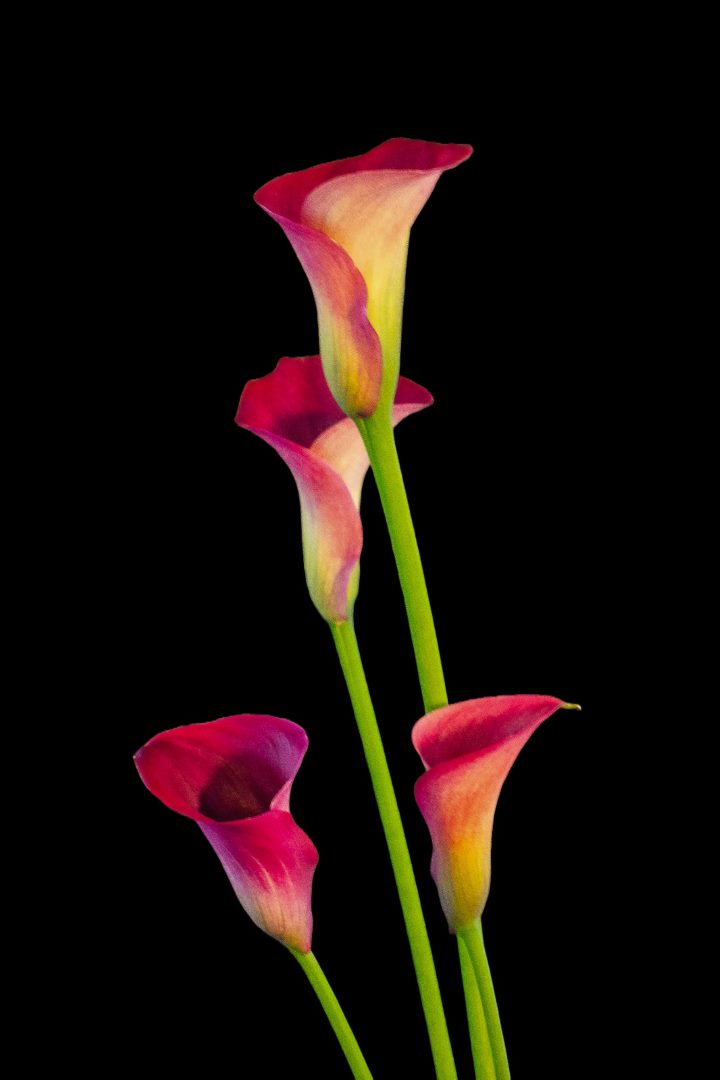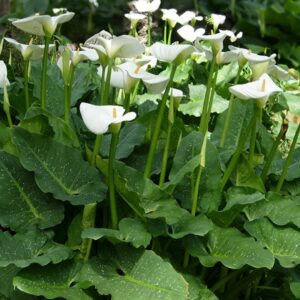Your cart is currently empty!
Understanding and Cultivating Matured Arum and Calla Lilies

Introduction
Arum lilies (Zantedeschia aethiopica) and Calla lilies (Zantedeschia spp.) are cherished for their stunning, elegant blooms. These rhizomatous herbaceous perennials are a favorite among gardeners and floral enthusiasts for their beauty and versatility. This comprehensive guide provides a detailed description of matured Arum and Calla lilies, detailing their growth habits, physical descriptions, and blooming patterns. By understanding these aspects, gardeners can better appreciate and cultivate these remarkable plants.
Description of Matured Arum Lilies
Arum lilies are known for their distinctive features and robust growth patterns. Here’s a detailed look at their characteristics:
Physical Characteristics
- Height: Arum lilies can grow up to 1.2 meters in height, making them a striking feature in any garden.
- Leaves: The leaves are upright, arrow-shaped, and typically plain green, although some species may have spotted patterns. These broad leaves add a lush, tropical feel to the garden.
- Inflorescences: The inflorescences are large and visually captivating, produced in spring, summer, and autumn. Each flower consists of a pure white spathe up to 25 cm long, encircling a yellow spadix that extends up to 9 cm. The spathe turns green after flowering and covers the ripening berries.
Growth Habit
Arum lilies grow from rhizomes, which are underground stems that store nutrients and support new growth. The stems of Arum lilies can vary significantly in length, ranging from 10 to 70 cm, depending on the specific species and growing conditions. These stems stand perfectly vertical, supporting the enclosed funnel-shaped flowers with slightly recurved tips.
Blooming Patterns
Arum lilies bloom multiple times throughout the year, primarily in spring, summer, and autumn. The blooms are faintly scented, adding a delicate fragrance to their visual appeal. The flowers’ vertical orientation and unique funnel shape make them a standout feature in any garden.
Description of Matured Calla Lilies
Calla lilies, another member of the Zantedeschia genus, are equally enchanting and come in a variety of colors and sizes. Here’s what you need to know about matured Calla lilies:
Physical Characteristics
- Height: Depending on the variety, Calla lilies can grow between 30 cm and 1.2 meters tall.
- Leaves: The leaves are typically green and arrow-shaped, often with white or silver speckles. These leaves are broad and add to the plant’s overall attractiveness.
- Inflorescences: The flowers, known as spathes, are available in a wide range of colors including white, pink, yellow, orange, and even deep purple. Each spathe surrounds a central yellow spadix.
Growth Habit
Calla lilies also grow from rhizomes and require similar care to Arum lilies. Their stems are sturdy and support the large, vibrant spathes. Calla lilies prefer well-drained soil and can thrive in both garden beds and containers.
Blooming Patterns
Calla lilies typically bloom in late spring to early summer. The vibrant spathes can last for several weeks, adding long-lasting color to the garden. After blooming, the spathes turn green and cover the developing berries.
Cultural Requirements
To cultivate healthy and vibrant Arum and Calla lilies, it is essential to provide the right growing conditions:
- Soil: Both Arum and Calla lilies prefer well-drained, fertile soil rich in organic matter. Consistent moisture is crucial, but the soil should not be waterlogged.
- Light: These plants thrive in partial shade to full sun. However, in hotter climates, providing some afternoon shade can prevent the foliage from scorching.
- Watering: Regular watering is necessary, especially during dry periods. Both types of lilies do well in moist environments, and consistent moisture levels support their lush growth and prolific blooming.
Varieties of Arum and Calla Lilies
Arum Lily Varieties
- Zantedeschia aethiopica: The classic Arum lily with large white spathes and a yellow spadix. It is the most common variety and is known for its robust growth and adaptability.
- Zantedeschia albomaculata: Known for its white spathes and spotted leaves. It is slightly smaller than Z. aethiopica and has a distinctive charm.
Calla Lily Varieties
- Zantedeschia ‘Black Magic’: Features deep purple, almost black spathes that make a dramatic statement in the garden.
- Zantedeschia ‘Cameo’: Boasts delicate pink spathes that are perfect for adding a soft touch to any floral arrangement.
- Zantedeschia ‘Flame’: This variety has vibrant orange and yellow spathes, reminiscent of flames, making it a standout choice for gardeners.
Conclusion
Arum and Calla lilies are captivating additions to any garden, with their majestic height, stunning spathes, and vibrant spadices. Understanding their growth habits, blooming patterns, and cultural requirements can help gardeners cultivate these beautiful plants successfully. By providing the right conditions and care, Arum and Calla lilies will thrive, bringing elegance and charm to any outdoor space.
References
- Detailed descriptions and care instructions from various horticultural sources.
- Insights on promoting blooming and general care tips for both Arum and Calla lilies.
- Comprehensive growing guides for different varieties of Zantedeschia.








Leave a Reply